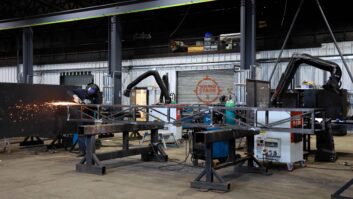The BBC has installed Stage Tec Nexus Star audio routers at its MediaCityUK site in Salford following a competitive tender against the BBC’s framework contract holders, writes David Fox.
It has placed Stage Tec Nexus Stars in the two main BBC buildings on the site, each fitted with the latest redundant routing and control cards to which are connected 21 Nexus Base Devices spread around all three buildings.
In total, the system has about 7,600 I/O channels with a mix of analogue, AES and MADI ports, which will be controlled by the broadcaster’s BNCS control system via touch screens or a scheduling system. The system makes extensive use of fibre and MADI for connections between the Star routers, Base Devices and the mixing and intercom systems.
The systems were supplied by Stage Tec’s UK distributor, Aspen Media, whose director, Chris Collings, commented: “Nexus is highly resilient in that in addition to the redundancy installed in each Star, the Base Devices are self-contained routers that can provide local routing independent of the central routers. The system will be used at MediaCityUK for linking studio and production areas in the building with external lines for connection to transmitters and other sites such as London’s Broadcasting House and TV Centre and various outside broadcast venues; as well as the audio router and comms system of the facilities operated by Peel Media.” The BBC also has a Nexus Star system at BBC Scotland in Glasgow.
The Nexus Star is a routing node serving as the core of a Nexus installation and interconnecting numerous Nexus Base Devices scattered over separate studios and apparatus areas via optical cables. It is designed to be a versatile audio-network and routing system for controlling studio or mixing-desk resources, for apparatus-area and broadcast-complex networking.
Each Nexus Star accommodates up to 16 boards with 256 inputs and 256 outputs, which provides routing for up to 4,096×4,096 I/O points (more than 16 million crosspoints). As at the BBC, multiple units can be cascaded, and any input can be routed to any output, so point-to-point lines as well as point-to-multi-point sets can be created.
Instead of a bus configuration, as used on the Nexus system, Nexus Star includes a dual matrix for routing inputs to outputs. This allows for a very high clock rate and thus supports the reliable implementation of an accordingly large number of time-slots, resulting in an internal throughput of more than 12Gbps.
Nexus Star acts as a star router, unlike the distributed structure of a traditional Nexus network. The Base Devices connect to the core router in a star configuration. This offers maximum flexibility and is easy to implement, with minimal cabling.
Nexus Star currently supports two different interface boards for carrying signals over long cable runs: the RFOC optical interface board for connecting other Nexus units and the RMF board for the MADI multichannel standard format. This enables large digital audio systems including, for example, mixing consoles or multitrack recorders to be connected directly. The system has a very low and constant latency of six samples for all signals, for live broadcast use.







